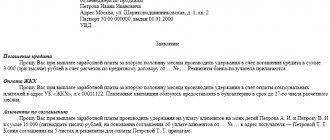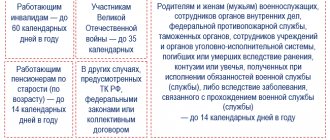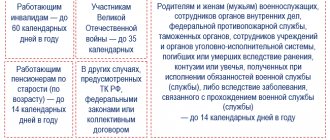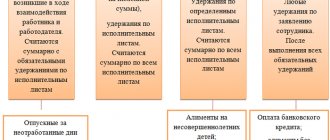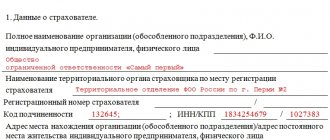What is the tariff system of remuneration. Differences from the tariff-free system
The tariff system includes a number of provisions, norms, rules and regulations that make up a unified method of calculation, as well as the calculation of employee wages. The form of remuneration under consideration differs significantly from the non-tariff form.
The tariff system takes into account the complexity of the work, its intensity, working conditions, qualifications of certain categories of personnel; only if the specified components are available and analyzed, the employee will be paid a salary.
The non-tariff system has fundamental differences: the wages of all employees of the enterprise depend on the results of the work of the entire enterprise and on the amount of money allocated by the employer to pay for the labor process.
A fundamentally important element of the non-tariff system is the coefficient that takes into account the individual contribution of each employee to the overall final result. The tariff-free system is distinguished by the fact that the salary of each member of the work team is part of the general wage fund.
The tariff system of remuneration includes the main elements:
- tariff schedules;
- tariff directories;
- tariff rates.
Do you need help from a labor lawyer?
We will analyze your prospects for free!
+7
Comparison
Thus, both the rate and the salary are the minimum established amount of labor, below which accruals cannot fall. Their definitions are indicated in Article 129 of the Labor Code of the Russian Federation, where the main differences are indicated. Thus, the rate is charged for fulfilling a certain norm, which is typical for construction, manufacturing and other similar areas. It can be calculated for a certain unit of time: hour, week, month.
The salary is accrued for the performance of job duties, where it is not possible to establish a standard. Its calculation is carried out per week, month or year and depends on the position held. In this case, the amount of the rate depends on the category of the employee (fitter of the first category, turner of the fourth category), and the amount of the salary depends on the qualifications of the employee (lawyer, leading specialist, head of department).
Accordingly, the range of professions will also vary significantly. If we are talking about the tariff rate, then it is applicable to those people who are employed in the real sector of the economy. These include the mining and manufacturing industries, construction and much more. The result of labor here can be expressed in solid form (produced parts, produced rock). As for the salary, it is applicable for areas where it is difficult to calculate the “socially useful product”. This is the work of civil servants, managers, and technical specialists.
Unified tariff and qualification reference books
These reference books are necessary to regulate the work of representatives of the main working professions, management positions, employees and specialists within the enterprise. Using the provisions of a single directory, you can determine the suitability of an employee for the position held.
The document contains requirements for personnel categories, descriptions for each type of activity, a listing of the employee’s skills and knowledge, and a list of professions related to each type of work.
The unified directory of positions for managers, employees, and specialists contains requirements for the qualifications, knowledge and education of these categories of workers and explains their main job responsibilities.
Using the provisions of the directory, various types of professional activities are compared according to the complexity of their components. In addition, categories and qualifications are determined. This process is generalized into the concept of “tariffication”.
Tariffing procedure
Tariffication occurs by comparing the work performed at the enterprise with the list and examples of work contained in a single directory. For pricing purposes, an enterprise can develop and introduce internal lists of work, and use them along with the main ones.
Depending on the rank, the salary of an employee of an enterprise varies. To transfer an employee from rank to rank, in accordance with the internal regulations of the organization, a qualification commission is formed and convened, and its chairman is elected.
The employee, in the presence of members of the commission, passes a qualification exam, which includes testing theoretical knowledge and, in some cases, practical skills. If the exam is passed successfully, the employee receives a certain rank or moves from one to another, which is recorded in his work book. To rate the salaries of managers, as well as employees and specialists, a single directory of the specified positions is used.
Tariff rates
The tariff rate is understood as a payment to an employee measured in monetary terms, taking into account his qualifications, nature and standards of work performed. Calculation of tariffs occurs both for time-based and piecework wages.
The tariff rate is a guarantee that the employee will receive money for work, provided that it is performed in good faith. Additional payments, bonuses, compensations are not included in the concept of “tariff rate”. Consequently, the tariff rate is the minimum wage for an employee, to which, in the process of wage formation and calculations, other components of wages are added.
Similarities between indicators
The salary in the salary takes up the largest part of the payment, as does the tariff rate. Additionally, compensation, incentive transfers or additional payments are included in earnings.
Salary and rate have the following similar parameters:
- money is paid at the end of a specified period, represented by a day, week or month;
- it is possible to calculate payments per hour, day or other period;
- To evaluate the work of any employee, a certain fixed rating is used.
If a person went on vacation or sick leave during the month, the fixed amount is reduced, so in any case the actual period worked is taken into account.
Both payroll systems take into account a certain tariff. When setting any indicator, the qualifications, level of responsibility and experience of the hired specialist are taken into account. These values are influenced by the situation on the labor market and the possibility of replacing an employee with another employee.
Tariff schedule and tariff category
The tariff schedule represents the ratio of tariff rates in accordance with the category. Designed in the form of a table for entering data. For different categories of work, tariff scales with different numbers of categories are provided.
Enterprises, as a rule, use a six-digit grid, where the first digit is the lowest and the sixth is the highest.
An enterprise, in accordance with its internal situation, can change the tariff scale towards increasing or decreasing its range. The instrument in question is used not only in relation to blue-collar professions. The tariff schedule is typical for calculating wages of public sector workers.
The tariff category shows the level of qualifications and skills of the employee and characterizes the complexity of the work he performs. The composition and size of an employee’s salary largely depends on the tariff category.
Basic elements and shapes
The tariff system has the following components:
- Tariff rate. It determines the amount of earnings according to the required number of working hours and the skill of the employee. It is calculated in isolation from incentive and compensation payments and is certainly specified in the working agreement. Tariff rates are used in industrial establishments where it is possible to compare the work done with the assigned standard.
- Salary . Sets the minimum salary and is not subject to other criteria. Does not cover miscellaneous allowances and bonus payments. It is used in organizations that do not analyze the results of planned volumes.
- Tariff schedule . Allows you to determine the proportion of the salary volume with the complexity of the work done. The tariff coefficient is used here.
Different forms of tariff system are possible:
- time-based (earnings are determined by the total number of working hours, salary or tariff rate - the so-called hourly rate);
- simple time-based (income is calculated in the form of salary at the end of the month);
- time-based bonus (salary for a certain time and bonuses are taken into account);
- piecework (the amount of work performed is important);
- chordal (the total labor as a whole is taken into account, and not individual operations).
The use of tariff systems for time-based and piecework wages
The main types of payroll calculation include:
- time payment;
- piece-work payment.
When calculating wages, the employer takes into account the following elements:
- grade of work;
- its characteristics;
- the standard time allotted for its implementation;
- tariff rate.
Calculation of piecework payment is made on the basis of the provisions of the unified tariff and qualification reference books. The most important component of work with piecework payment is production. One of the main disadvantages of piecework payment is the high probability that, in an effort to produce more products, the employee will not pay due attention to the quality of the finished product.
When calculating time wages, the amount of money an employee receives monthly depends on his rank. Also, when calculating time-based wages, the amount of time worked plays a significant role, which fundamentally distinguishes this form of payment from piecework.
Time-based payment requires mandatory staff pricing and clear timekeeping of the time spent by the employee on work. Today, most enterprises produce time-based wages, recognizing it as a more convenient type of payment for the parties to labor relations than piecework wages.
Salary concept
It is represented by the exact and constant amount of the employee’s earnings, which is paid monthly when the allotted time is worked. Funds are accrued for the performance of labor duties specified in the employment contract.
To receive a payment, the following conditions must be met:
- the employee follows the provisions of the job description;
- works during the month according to the work schedule;
- present at the workplace.
Attention! An employee’s salary differs from salary, since bonuses, allowances, compensation and incentive payments are also included in the total earnings.
If an employee misses work without good reason, the employer can reduce the salary, for which only the time actually worked is taken into account. Although the amount is fixed in the employment agreement, it must change regularly, since indexation is required based on the level of inflation and the minimum wage.
Procedure for establishing tariff systems
Russian labor law in its provisions determines the procedure for establishing tariff systems. Regardless of the legal form of the organization and the type of its activity, the tariff payment system is established by local regulations, provisions of collective agreements, and agreements.
Also, when establishing tariff systems, the data of the unified tariff and qualification reference book are fundamentally taken into account, taking into account all the requirements of the labor legislation of the Russian Federation and other regulations mandatory for execution on the territory of the Russian Federation. The employer, when introducing tariff systems to the enterprise, must respect the rights of the employee and create decent working conditions.

